The passion of youth meets the wisdom of age
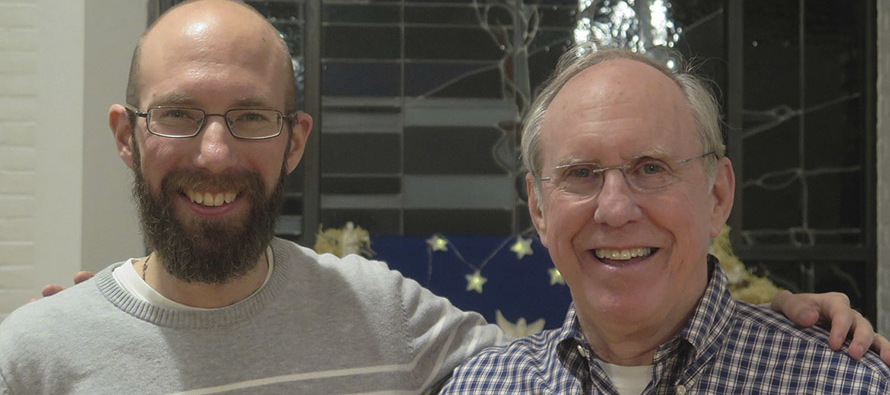
Friar Matthew Gummess, O.Carm. (left) shares a moment with fellow friar, Father Quinn Connors, O.Carm. (Photo courtesy of the Order of Carmelites)
No doubt about it, there’s been a demographic shift going on in religious communities for some time. There are more older religious than younger new members (whose smaller numbers are actually historically typical though).
So what is it like when God calls you to religious life during such change? Four younger religious report on their own experiences.
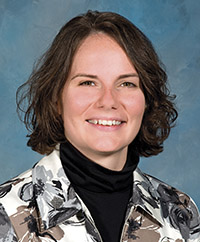
The grace of living with elders
By Sister Michelle Lesher, S.S.J.
Exiting the room of one of our 80-something sisters, I smiled, aware that we had just shared a profound moment. In our conversation, we reminded each other of the essence of our call to be Sisters of Saint Joseph. We talked about God, prayer, and the joys and struggles of community life. We laughed, cried, sat quietly, and told tons of stories; in the midst of all of that, we even played a few hands of cards—which she always won. Talk about holy ground!
In conversation, we realized just how much we share in common. I was struggling to adjust to my new and utterly unfamiliar life as a novice, missing teaching in one of our academies. She was grappling with retiring after nearly 30 years in ministry. An unlikely pair, one at the beginning of her religious life, another nearing the end, we spent every Monday afternoon together for a year. We both believed that those visits helped to steady each of us as we entered new life terrain. Across the decades, heart speaks to heart.
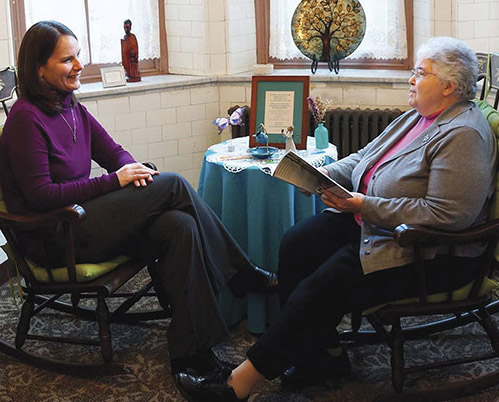
People often ask if I ever hesitated in joining an order where there are more wisdom figures then peers. The truth is, I didn’t notice because I was too busy being inspired by these women who were living a life that matched the one to which I felt called. These women are my mentors and sisters. I am increasingly amazed to find that despite having grown up in different times, our stories about feeling compelled by religious life are remarkably similar. When we talk about matters of the heart and what is central to our religious life—relationship with God and service to our dear neighbor—age isn’t all that significant. I felt drawn to the mission of the Sisters of Saint Joseph and questions around age never deter that call.
If I am honest though, during my 13 years in religious life, I have seriously pondered this notion of age gap, especially since I have lived mostly with sisters older than my parents. That has led me to rich networking with women religious in a variety of congregations who are my peers. This is essential as we shape together the future of religious life, particularly in the United States. I believe that God is giving us the grace necessary to be bridges across this gap. Intergenerational living is possible and meaningful.
I came to religious life because I felt called to this particular lived expression of relationship with God in service to others. So did my sisters who are 10 or 60 years older than I am. When we live the essence of our life, age doesn’t matter. It is really about sharing those heart-to-heart moments with my sisters. For, as Rumi reminds us, “we are all just walking each other home.”
Sister Michelle Lesher, S.S.J. is a Sister of Saint Joseph of Philadelphia serving in vocation and formation ministry.
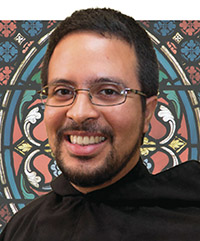
Community comes in many forms
By Father Carlos Medina, O.S.A.
Living in a community of various generations can be difficult at times, but underneath it all, the call to live our vocations deeply and together is very fulfilling. My experiences with intergenerational living have run a wide range, with age being really only one factor that influenced the experience for me.
I entered the novitiate—the first step in formally entering a community—right out of college. I did not go through this process of deepening interiority alone but along with my novice classmates and with the support of the formation community. My three novitiate classmates were all at least 10 years older than me, and the formation community was five priests and a brother all the age of my grandparents. Yet somehow, living with considerably older men did not seem odd to me. A visitor to our community that year pitied me because I was so young and lived among elderly men. I, on the other hand, felt honored to begin my religious life among men who were deeply, radically following Christ.
After professing vows, I went on to theological studies in Chicago. During this time, I lived with younger friars in formation (preparation) and with a younger formation team. After two years of studies, I did pastoral ministry for a year and lived once again with much older men. This second time living with significantly older friars was difficult for me. I often felt disconnected during social time when conversations focused on people or events I did not know. I also didn’t have any peers my age. Prayer, a fulfilling ministry, and friends outside community who supported my vocation proved to be quite a gift.
After that pastoral year, I went back to finish my theological studies, and then was ordained. The community I live in today has taught me that age is not the only factor in connecting with people. I have been able to connect with the elderly men in my current household, who are like me, relatively new to the local community. So I have realized that perhaps my struggle to connect during my pastoral ministry year was not so much due to age differences, but to the fact that it was a group that had not changed much for several years. In my new local community, some of the older members and the younger members are new to the living arrangement, with little knowledge of the local people and places. This dynamic makes connecting with one another much easier.
For me, as a younger religious, age matters . . . and it doesn’t matter. For a while I will continue to be one of the younger men in my province, but God willing, I will be an elderly member one day. As I age and mature, I look forward to continuing to pray together and sharing life and ministry with my Augustinian brothers.
Father Carlos Medina, O.S.A., an Augustinian priest, is a pastor associate at St. Patrick Catholic Parish in San Diego.
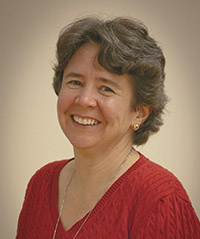
Missing peers but loving community
By Sister Belinda Monahan, O.S.B.
As I pushed a cart full of dishes down the hallway one Sunday morning, a sister stopped me and said, “When I was young, I . . . ” I’m not certain what she said next because all I could think was, “I’m not young!” In my mid-40s, I live in virtually the only context in which I can be (and frequently am!) called young. I am more than 30 years younger than the median age of my community and seven years younger than the next youngest. When my fellow community members call me young, it’s usually meant with affection, sometimes tinged with envy. It occasionally makes me feel as though the entire future of the order is resting on my very uncertain shoulders. But it is also a responsibility I carry proudly, as a “young” woman religious, I am called to be a bridge between people, as I follow the women who came before me and lead the way into the future.
When I started looking at religious communities in my mid-30s, I did not really consider the fact that in most of the communities I visited, I would be one of the younger sisters. The communities to which I was attracted were not necessarily the younger communities, but those in which people were interested and engaged in the world around them. This isn’t tied to age. At 103, Sister Vivian is the oldest member of our community, but she still reads the newspaper every day and can be counted on to have a strong, well-informed opinion about current events.
Most of the sisters in my community are closer to Sister Vivian in age than to me and many are “retired” from active ministry. It has largely been these women who walk with me as I learn what it means to be community. They are the ones who could make space in their lives to answer my questions and listen to my frustrations. The breadth of their experience means that even if they don’t have the answers, they can understand and sympathize with the questions. The women who have lived steeped in the Rule of Benedict and have been faithful to monastic life for 60, 70, or even 80 years provide a joyful and living example of what the fruits of that life can look like.
Sometimes I do miss having peers in community. It would be nice if one or two other people in the room knew who Buffy the Vampire Slayer was or could help with the struggles I face in balancing ministry and community life. The scarcity of peers in my own community, however, means that I have worked to seek out peers in religious life outside of my own community, broadening my understanding of what religious life can be. The downside of having to work harder to find people who understand my pop culture references is more than balanced by the examples I have to follow and to live up to as a “younger” woman in this adventure of religious life.
Sister Belinda Monahan, O.S.B. is vocation director for the Benedictine Sisters of Chicago.
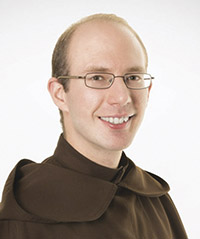
Yes to this life despite worries
By Friar Matthew Gummess, O.Carm.
Peter and I decided not to chance a risky journey back to Juárez, Mexico since it was getting on toward dusk. That’s how we ended up in a sweltering, windowless hostel room in El Paso, Texas, the ancient ceiling fan thwacking away like a helicopter blade without doing much to alleviate the room’s dead air. No problem for Peter, though. He stripped down to boxers and a t-shirt and was asleep in five minutes, while I lay there sweating uncomfortably. I looked over and shook my head. Here were a couple of friars—me in my 20s, him pushing 90—and yet I felt like I was crashing somewhere with a college buddy.
Age gap? What age gap?
I admit, Father Peter does not exactly represent the norm. I’d gone to Juárez not so much to see the ministry of presence he exercises there as to see him. He’s a legend in the province for his vitality and joie de vivre, and he’s still down in Juárez, counseling victims of violence and saying Masses for the poor in his “retirement.” He’s extraordinary in every way—except one. His age is closer to the average in my province than my own. We’re not anywhere close to bringing enough new blood in to maintain our ministries at the current level. And so the immediate future looks very different from the immediate past.
Five men joined with me, all from North America, all under 40, and I was young and naive enough not to worry about the looming demographic crunch. The ideal of religious life had so captivated me that I couldn’t even see the writing on the wall. But I’ve been in long enough now that communities I’ve loved have been shuttered, and brothers I’ve loved have left—some have passed away. Funerals outnumber professions. I professed solemn vows in August 2016 with one other brother, and I admit that in darker moments, I wonder which one of us will turn out the lights when everyone else is gone.
But I’ve stayed because a community with more elders than peers is still a community. I’ve stayed because Peter, though extraordinary, is far from being the only friar who defies the logic of age differences. I’ve stayed because I believe the God who called Peter is the same God who is gently calling me. I’ve stayed because I hope that the ever-living God does have a future for us, even if that future places me in Indonesia or Vietnam, where there are far more young Carmelites than old. I’ve stayed, in the end, because I love Carmel, and when all is said and done, I want to be buried in that long row of Carmelites, next to the saints and the scoundrels, and I want to stand before God having said yes, like so many before me.
Like Peter, who first said yes so very many years ago, and is still saying yes today.
Friar Matthew Gummess, O. Carm., of the Province of the Most Pure Heart of Mary, resides in Washington, D.C., where he is studying for ordination at the Catholic University of America.
Related article: VocationNetwork.org, “Thriving among the generations.”
Tags
Related
- Questions you’ll be glad you asked
- What monastic mystics got right about life
- Religious communities embrace diverse members
- How my parents responded when I became a brother
- Vocation Basics: You are already called—Message to youth from Pope Francis
- Meet the parents
- Charism: The gift that shapes lives
- What our vows mean
- Discover five treasures of religious life
- Religious making a difference Read More
Most Viewed
- Find your spirituality type quiz
- Questions and answers about religious vocations
- Celibacy quiz: Could I be a nun? Could I be a brother? Could I be a priest?
- Resources for older discerners or those with physical and developmental differences
- About Vocation Network and VISION Guide

